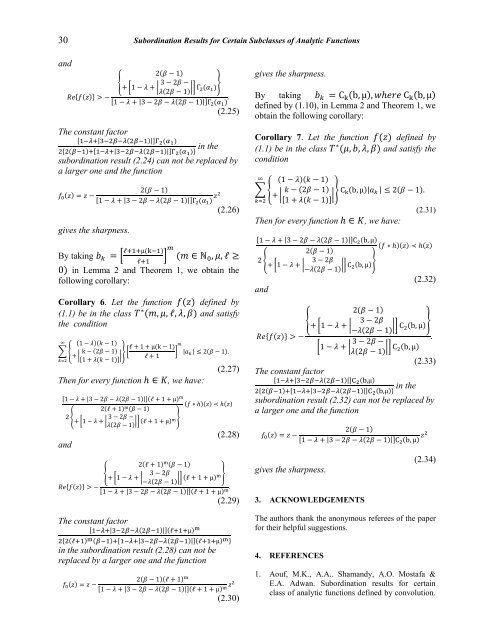TITLE MARCH 2012 - Pakistan Academy of Sciences
TITLE MARCH 2012 - Pakistan Academy of Sciences
TITLE MARCH 2012 - Pakistan Academy of Sciences
You also want an ePaper? Increase the reach of your titles
YUMPU automatically turns print PDFs into web optimized ePapers that Google loves.
30 Subordination Results for Certain Subclasses <strong>of</strong> Analytic Functions<br />
and<br />
2(β − 1)<br />
<br />
+ 1 − λ + 3 − 2β −<br />
λ(2β − 1) Γ 2(α 1 ) <br />
Re{f(z)} > −<br />
[1 − λ + |3 − 2β − λ(2β − 1)|]Γ 2 (α 1 ) .<br />
The constant factor<br />
[1−λ+|3−2β−λ(2β−1)|]Γ 2 (α 1 )<br />
2{2(β−1)+[1−λ+|3−2β−λ(2β−1)|]Γ 2 (α 1 )}<br />
in the<br />
(2.25)<br />
subordination result (2.24) can not be replaced by<br />
a larger one and the function<br />
2(β − 1)<br />
f 0 (z) = z −<br />
[1 − λ + |3 − 2β − λ(2β − 1)|]Γ 2 (α 1 ) z2<br />
gives the sharpness.<br />
(2.26)<br />
By taking b k = l+1+μ(k−1)<br />
m (m ∈ N<br />
l+1<br />
0 , μ, l ≥<br />
0) in Lemma 2 and Theorem 1, we obtain the<br />
following corollary:<br />
Corollary 6. Let the function f(z) defined by<br />
(1.1) be in the class T ∗ (m, μ, l, λ, β) and satisfy<br />
the condition<br />
∞ (1 − λ)(k − 1)<br />
l + 1 + μ(k − 1)<br />
k − (2β − 1)<br />
+ <br />
[1 + λ(k − 1)] <br />
l + 1<br />
k=2<br />
Then for every function h ∈ K, we have:<br />
m<br />
|a k | ≤ 2(β − 1).<br />
(2.27)<br />
[1 − λ + |3 − 2β − λ(2β − 1)|](l + 1 + μ) m<br />
(f ∗ h)(z) ≺ h(z)<br />
2(l + 1) m (β − 1)<br />
2 <br />
+ 1 − λ + 3 − 2β −<br />
λ(2β − 1) (l + 1 + μ)m<br />
and<br />
(2.28)<br />
2(l + 1) m (β − 1)<br />
<br />
3 − 2β<br />
+ 1 − λ + <br />
(l + 1 + μ)m<br />
−λ(2β − 1)<br />
Re{f(z)} > −<br />
[1 − λ + |3 − 2β − λ(2β − 1)|](l + 1 + μ) m.<br />
(2.29)<br />
The constant factor<br />
[1−λ+|3−2β−λ(2β−1)|](l+1+μ) m<br />
2{2(l+1) m (β−1)+[1−λ+|3−2β−λ(2β−1)|](l+1+μ) m }<br />
in the subordination result (2.28) can not be<br />
replaced by a larger one and the function<br />
2(β − 1)(l + 1) m<br />
f 0 (z) = z −<br />
[1 − λ + |3 − 2β − λ(2β − 1)|](l + 1 + μ) m z2<br />
(2.30)<br />
gives the sharpness.<br />
By taking b k = C k (b, μ), where C k (b, μ)<br />
defined by (1.10), in Lemma 2 and Theorem 1, we<br />
obtain the following corollary:<br />
Corollary 7. Let the function f(z) defined by<br />
(1.1) be in the class T ∗ (μ, b, λ, β) and satisfy the<br />
condition<br />
∞ (1 − λ)(k − 1)<br />
k − (2β − 1)<br />
+ <br />
[1 + λ(k − 1)] C k (b, μ)|a k | ≤ 2(β − 1).<br />
k=2<br />
Then for every function h ∈ K, we have:<br />
(2.31)<br />
[1 − λ + |3 − 2β − λ(2β − 1)|]C 2 (b, μ)<br />
(f ∗ h)(z) ≺ h(z)<br />
2(β − 1)<br />
2 <br />
3 − 2β<br />
+ 1 − λ + <br />
−λ(2β − 1) C 2 (b, μ)<br />
and<br />
(2.32)<br />
2(β − 1)<br />
<br />
3 − 2β<br />
+ 1 − λ + <br />
−λ(2β − 1) C 2(b, μ) <br />
Re{f(z)} > −<br />
1 − λ + 3 − 2β −<br />
.<br />
λ(2β − 1) C 2(b, μ)<br />
The constant factor<br />
[1−λ+|3−2β−λ(2β−1)|]C 2 (b,μ)<br />
2{2(β−1)+[1−λ+|3−2β−λ(2β−1)|]C 2 (b,μ)}<br />
in the<br />
(2.33)<br />
subordination result (2.32) can not be replaced by<br />
a larger one and the function<br />
2(β − 1)<br />
f 0 (z) = z −<br />
[1 − λ + |3 − 2β − λ(2β − 1)|]C 2 (b, μ) z2<br />
gives the sharpness.<br />
3. ACKNOWLEDGEMENTS<br />
(2.34)<br />
The authors thank the anonymous referees <strong>of</strong> the paper<br />
for their helpful suggestions.<br />
4. REFERENCES<br />
1. Aouf, M.K., A.A.. Shamandy, A.O. Mostafa &<br />
E.A. Adwan. Subordination results for certain<br />
class <strong>of</strong> analytic functions defined by convolution.

















